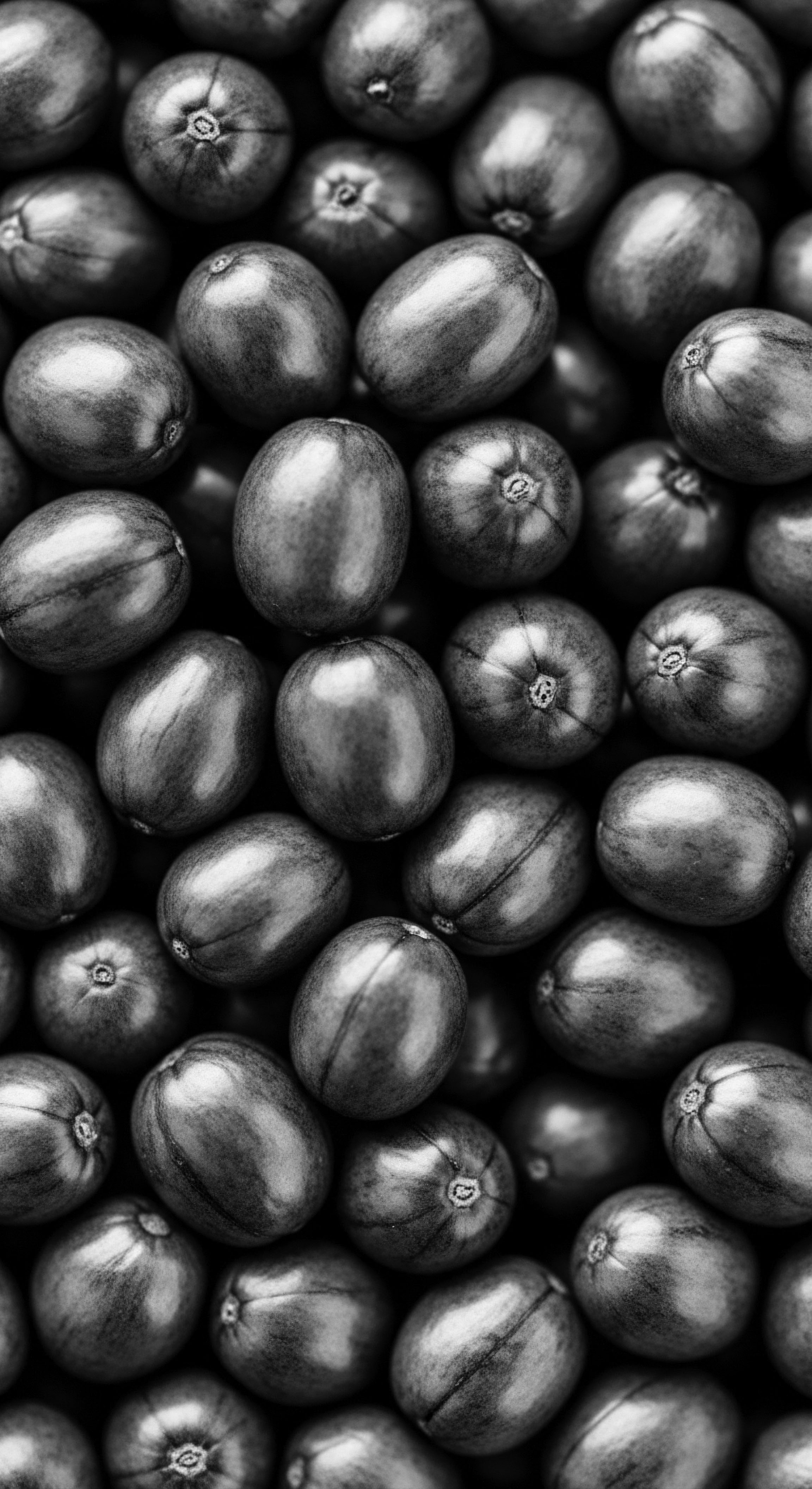
Fundamentals
The concept of Black Walnut Hair, as understood through the lens of heritage and traditional care practices, refers to hair that either directly benefits from the venerable properties of the Juglans nigra tree or symbolically embodies its enduring qualities. This interpretation acknowledges both the direct application of black walnut elements in hair rituals and a deeper appreciation for textured hair’s innate resilience, echoing the strength and rich tones associated with this ancient tree. When we speak of Black Walnut Hair in its most straightforward sense, we consider the use of the plant’s hulls, leaves, or bark, particularly for their remarkable ability to impart deep, earthy hues and offer various scalp benefits. This natural pigment, stemming from compounds such as juglone and tannins, provides a gentle approach to enriching dark hair tones without harsh chemicals.
Across diverse ancestral communities, the black walnut has been a revered natural resource, not only for sustenance but also for its contributions to cosmetic and medicinal applications. Its inclusion in hair care rituals speaks to a profound ecological awareness, where understanding of the natural world provided solutions for aesthetic expression and well-being. The gentle conditioning and subtle darkening effects that black walnut preparations bestow upon hair represent a harmonizing of human ingenuity with the Earth’s provisions, a practice deeply ingrained in the fabric of many historical hair traditions.
Black Walnut Hair, at its core, represents a historical and symbolic connection between ancestral practices using the Juglans nigra tree and the inherent strength and beauty of textured hair.
The description of Black Walnut Hair thus begins with an acknowledgment of these tangible applications. The outer green husk of the black walnut, for instance, contains the potent pigment juglone, which acts as a direct dye on protein fibers, including hair. This substance, alongside a considerable concentration of tannins, provides a spectrum of deep brown to black shades.
Beyond coloring, the natural astringent properties of tannins in black walnut shells contribute to scalp health, helping to cleanse and invigorate. This duality of aesthetic enhancement and restorative care underscores the holistic approach often found in heritage hair practices.
Delving into its meaning, the practice of utilizing black walnut for hair care also conveys a sense of self-sufficiency and resourcefulness. Communities relied on their immediate natural surroundings for all aspects of life, including personal adornment. This connection to the land and its gifts is a fundamental aspect of the Black Walnut Hair concept, tying it directly to the wisdom passed down through generations.

Intermediate
Moving beyond the basic utility, the intermediate meaning of Black Walnut Hair explores its more intricate relationship with heritage, wellness, and the subtle scientific underpinnings that affirm ancestral wisdom. This approach recognizes the Juglans nigra tree not only as a source of dye but also as a powerful symbol within the broader narrative of textured hair. The term signifies a hair philosophy deeply rooted in the appreciation for natural processes and a gentle, earth-attuned approach to hair care that aligns with historical precedent.

The Ancestral Hand in Hair’s Pigmentation
For centuries, long before the advent of synthetic dyes, various cultures harnessed the Earth’s bounty to adorn themselves, and hair was no exception. The black walnut, indigenous to eastern North America, holds a particularly significant place in this history, especially among indigenous peoples and early settlers. The Meskwaki Tribe of the Great Lakes, for instance, were known for creating black dye from the bark of the black walnut. This historical precedent speaks volumes about the deep observational knowledge held by these communities, recognizing the tree’s powerful staining capabilities.
The colonists, initially struggling to cultivate European walnut species (Juglans regia), turned to the native black walnut for dyeing their textiles, and indeed, for coloring hair. This adaptation speaks to an exchange of knowledge and a recognition of the indigenous plant’s efficacy.
The application of black walnut to hair transcends mere aesthetics. Ancient hair rituals often carried medicinal and spiritual weight. The tannins present in the walnut, beyond their dyeing capabilities, possess astringent properties that could soothe scalp irritations or help manage excess oil. This dual function, where beauty and healing coalesce, is a hallmark of traditional hair care, a practice that understood the scalp as an extension of the body’s overall well-being.
Ancestral approaches to Black Walnut Hair reveal a harmonious interplay between aesthetic expression and holistic wellness, reflecting a profound understanding of natural remedies.

Components and Their Cultural Roles
The science behind black walnut’s effect on hair lies primarily in two compounds ❉ Juglone and Tannins. Juglone, a naphthoquinone, reacts with the hair’s protein, imparting a dark tone. Tannins, common in many plants, contribute to the pigment and act as natural astringents.
The very act of collecting the green husks, processing them through simmering or steeping, and then applying the resulting liquid to hair or textiles was a ritual, a connection to the land and its cycles. This was not a passive consumption of products but an active participation in the creation of one’s adornment, linking the individual to a communal heritage of resourcefulness.
Consider the intricate relationship between hair and identity within Black and mixed-race communities throughout history. Hair has served as a powerful medium for communication, status, and resistance. The use of naturally sourced dyes like black walnut, in contexts where synthetic options were either unavailable or harmful, allowed for self-expression that was both beautiful and aligned with natural principles. It provided a means to maintain deep, rich hair tones that often align with the natural spectrum of Black hair, celebrating its inherent color without harsh chemical alterations.
- Husks (Pericarps) ❉ These outer coverings are the primary source of the dark pigment juglone. Historically, their preparation involved crushing or boiling to extract the coloring agents, yielding rich browns and near-blacks for hair.
- Leaves ❉ While less potent for dyeing, black walnut leaves contain tannins and juglone. They were sometimes used in rinses, offering milder coloring effects and contributing to scalp health.
- Bark and Roots ❉ These parts also hold dyeing properties and were utilized by certain indigenous groups to create darker dyes, further illustrating the comprehensive use of the tree.
The decision to use such natural elements was often born of necessity and a deep-seated knowledge of botanical properties. It represented a careful selection from nature’s palette, guided by generations of observation and practical experience. This deliberate choice is part of the deep ancestral memory that Roothea strives to rediscover, emphasizing the efficacy and inherent wisdom of these practices.
| Aspect Pigment Source |
| Traditional Black Walnut Hair Practice Green or ripe outer husks of Juglans nigra (black walnut). |
| Modern Natural Dyeing Perspective Concentrated extracts of juglone and tannins from black walnut, often combined with other plant powders like henna or indigo. |
| Aspect Application Method |
| Traditional Black Walnut Hair Practice Direct rubbing of husks onto hair or using decoctions/infusions as rinses. |
| Modern Natural Dyeing Perspective Formulated powders or liquids applied as hair masks or conditioning treatments, seeking enhanced color and longevity. |
| Aspect Benefits Beyond Color |
| Traditional Black Walnut Hair Practice Scalp soothing, natural astringent properties from tannins, potential for strengthening hair. |
| Modern Natural Dyeing Perspective Antimicrobial and antifungal benefits, scalp exfoliation (especially with shell powder), promotion of healthy hair growth. |
| Aspect The enduring legacy of black walnut's application underscores a continuous journey of understanding how natural elements serve hair wellness across different eras. |

Academic
The academic definition of Black Walnut Hair transcends anecdotal accounts to anchor itself in ethnobotanical studies, phytochemistry, and the cultural anthropology of hair. It stands as a conceptual construct, a rigorous interpretation of hair that is intrinsically linked to the biological and historical utility of Juglans nigra, the black walnut, within human societies, particularly those with a profound connection to natural hair practices and ancestral traditions. This deeper understanding necessitates an examination of the precise chemical components, their interactions with hair keratin, and the socio-cultural contexts that elevated the black walnut from a mere tree to a revered element in heritage hair care.

Phytochemistry and Hair Fiber Interaction
At its core, the interaction of black walnut preparations with hair is a fascinating study in natural biochemistry. The primary chromophore responsible for the dark pigmentation derived from black walnut is Juglone (5-hydroxy-1,4-naphthoquinone). This organic compound, highly concentrated in the fresh green husks of the black walnut, reacts with the amino acids present in hair keratin, forming stable, dark-colored complexes.
Unlike many synthetic dyes that chemically alter the hair shaft through oxidative processes, juglone acts as a direct dye, depositing pigment onto the hair’s cuticle and, to a lesser extent, the cortex. This method of color deposition is generally considered less damaging to the hair’s structural integrity, aligning with the principles of gentle, restorative care found in ancestral practices.
Co-occurring with juglone are high concentrations of Tannins, polyphenolic compounds known for their astringent properties. These tannins not only contribute to the depth and fastness of the color by binding with hair proteins but also provide demonstrable benefits for scalp health. Research indicates that tannins possess antimicrobial and anti-inflammatory qualities, which would have historically addressed common scalp conditions such as dandruff or minor irritations, thereby promoting a healthier environment for hair growth. The presence of L-arginine in walnuts also supports scalp circulation and root strength, providing a physiological basis for traditional claims of hair strengthening.
The scientific explanation for black walnut’s effect on hair involves juglone’s direct dye action and tannins’ astringent, antimicrobial properties, affirming long-held ancestral beliefs in its efficacy.

Cultural Anthropology of Plant-Based Dyes and Textured Hair
The history of hair coloring is as old as humanity itself, with natural ingredients like henna, indigo, and indeed, black walnut, serving as foundational elements across civilizations. The practice of coloring hair was rarely a superficial act. It often held deep social, spiritual, and medical significance.
For many indigenous North American tribes, including the Cherokee and Chippewa, the black walnut’s bark, roots, and husks were not just sources of brown and black dyes for textiles, but also for personal adornment and medicinal applications. This underscores a profound cultural intimacy with the natural world, where botanical resources were understood and utilized in multifaceted ways for collective well-being and identity expression.
A powerful historical example of plant-based dyes intersecting with hair heritage can be observed in the broader context of pre-colonial African societies. While specific data on black walnut use in Africa is limited due to its native range primarily being North America, the principle of using local botanical resources for hair adornment and care is a widespread ancestral practice across the continent. Women in various African communities, like the Basara Arab Women of Chad with their use of Chebe powder, relied on natural concoctions of herbs, seeds, and plants to protect hair, retain length, and enhance its strength. This shared reverence for plant-based solutions, whether it was the black walnut in North America or Chebe in Chad, highlights a universal ancestral wisdom regarding sustainable beauty practices.
These traditions were not merely about altering appearance but were deeply tied to community, identity, and a profound respect for the inherent power of the Earth’s offerings. The absence of harsh chemicals in these traditional methods also speaks to an intuitive understanding of gentle care, preserving the hair’s integrity rather than stripping it.
The societal implications of hair color within textured hair communities are particularly salient. Throughout history, for Black and mixed-race individuals, hair has been a canvas for resistance and a symbol of cultural pride, especially in the face of imposed Eurocentric beauty standards. The choice to use natural dyes, such as those derived from black walnut, could be seen as an act of reclaiming autonomy over one’s appearance, aligning with ancestral aesthetics and rejecting practices that could harm the hair or diminish its natural characteristics. This nuanced perspective on Black Walnut Hair places it within a powerful continuum of self-determination and the celebration of inherent beauty.

Interconnectedness and Long-Term Consequences
The academic investigation into Black Walnut Hair also considers the long-term implications of natural versus synthetic dyes. While modern synthetic hair dyes offer a wide range of colors and predictable results, they often contain chemicals that can cause irritation, allergic reactions, and have been linked to potential health concerns over prolonged exposure. Conversely, natural dyes, including those from black walnut, are generally regarded as having lower irritation potential and being more eco-friendly.
This distinction holds significant weight for individuals seeking alternatives that align with holistic health philosophies and environmental consciousness. The historical continuity of plant-based dyeing offers a compelling counter-narrative to the chemically intensive practices of modern hair care, providing insights into sustainable beauty for future generations.
The application of black walnut in hair care, from an academic vantage point, offers valuable lessons in bio-mimicry and sustainable practices. The compounds in black walnut, particularly juglone and tannins, demonstrate how nature provides effective solutions that can be gentle on both the human body and the planet. Understanding this traditional knowledge, rigorously backed by modern scientific inquiry, provides a foundation for developing contemporary hair care products that honor ancestral wisdom while meeting current demands for safety and efficacy. This approach allows for a renewed appreciation of plants like the black walnut, recognizing their deep history of service to human well-being and aesthetic expression, especially for textured hair which has often sought strength and integrity in its styling.
- Juglone’s Direct Dyeing Mechanism ❉ This naphthoquinone binds to keratin proteins on the hair surface, depositing color without requiring harsh oxidation, preserving hair’s inherent structure.
- Tannins’ Conditioning and Astringent Effects ❉ Beyond color, tannins provide natural conditioning, reducing frizz, and offering astringent properties that cleanse and tone the scalp, addressing common concerns for textured hair.
- Ancestral Ethnobotanical Wisdom ❉ The systematic use of black walnut by indigenous communities speaks to generations of refined knowledge concerning plant properties, predating modern chemistry.
The meaning of Black Walnut Hair, therefore, is not fixed but dynamic, evolving from elemental biology to a complex cultural statement. It signifies a hair state that is vibrant, resilient, and deeply rooted in a legacy of intentional, respectful care, much like the mighty tree from which its essence is drawn. It prompts us to consider the reciprocal relationship between humanity and the botanical world, a bond cultivated over millennia, particularly within communities whose beauty traditions have been shaped by the gifts of the earth.

Reflection on the Heritage of Black Walnut Hair
To contemplate the notion of Black Walnut Hair is to stand at the confluence of deep historical currents and the living stream of present-day care. It is a profound meditation on the enduring soul of a strand, tracing its lineage back to the very earth and the hands that first coaxed beauty from its botanical offerings. The journey of textured hair, especially for Black and mixed-race communities, has always been one of resilience, a testament to an unwavering spirit that has found ways to adorn, protect, and express identity even amidst challenge. The black walnut, with its formidable root system and generous husks, serves as a poignant symbol in this ongoing story.
This journey invites us to look beyond fleeting trends and embrace a legacy of care that prioritizes inherent hair health and respectful engagement with natural resources. The tradition of utilizing black walnut, whether for its rich, deepening hues or its gentle cleansing attributes, represents an alignment with ancestral rhythms, a quiet refusal to sever the cord of connection to the Earth that sustained generations past. It beckons us to remember that true beauty often springs from simplicity, from the intelligent application of what the world offers freely, steeped in knowledge cultivated over countless seasons.
In the whispers of history, we hear the echoes of women and men, guided by intuitive wisdom, preparing their tinctures and pastes, understanding the properties of plants like the black walnut with a knowing that transcended formalized science. Their practices were not merely functional; they were acts of self-love, community-building, and cultural affirmation. This ancestral blueprint for hair care, interwoven with the fibers of plant life, reminds us that the hair on our heads carries stories, traditions, and the very essence of our collective past. It calls upon us to recognize the profound agency in choosing practices that honor this heritage, preserving not just the health of our hair, but the integrity of our cultural memory.

References
- Alkhawajah, A. (1997). Medicinal plants and traditions of the Indian, Greek, and Arab cultures.
- Bézanger-Beauquesne, L. et al. (1990). Plants used in medicine.
- Clark, A. M. et al. (1990). Antimicrobial activity of Juglone.
- Cui, Z. et al. (2022). Recent advancements in natural plant colorants used for hair dye applications ❉ A review.
- Foti, C. Romita, P. Angelini, G. and Bonamonte, D. (2015). Allergic Contact Dermatitis to Walnut (Juglans Regia) Husk.
- Ghosh, S. & Sinha, S. (2008). Hair colors ❉ Classification, chemistry and a review of chromatographic and electrophoretic methods for analysis.
- Girzu, M. et al. (1998a). Sedative effect of walnut leaf extract and juglone, an isolated constituent.
- Nahrstedt, A. et al. (1981). Antifungal properties of juglone.
- Sharma, A. et al. (2009). The walnut tree in Indian, Greek, and Arab cultures.
- Soderquist, C.J. (1973). Juglone and allelopathy.
